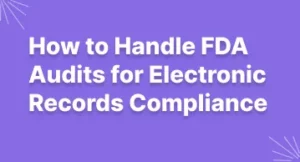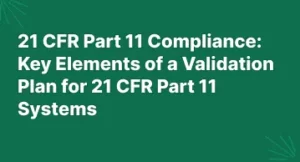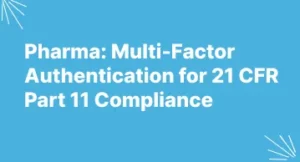What is 21 CFR Part 606? An Essential Guide to FDA Compliance
Introduction to FDA 21 CFR Part 606
The FDA 21 CFR Part 606 regulations are designed to regulate the safety of both food and drug products. This federal regulation, implemented by the Food and Drug Administration (FDA), outlines the requirements that must be followed to ensure that consumers are not exposed to unsafe products. It applies to a variety of products ranging from dietary supplements, prescription drugs, medical devices, and even food.
21 CFR Part 606 lays out the framework of guidelines for manufacturers, distributors, and researchers. It ensures that products that reach the general public are safe and do not pose any health threats.
FDA 21 CFR Part 606
The Food and Drug Administration (FDA) 21 CFR Part 606 is a regulation aimed to ensure the safety of food, dietary supplements, and clinical trials. It is composed of numerous sections which cover different areas of regulation.
21 CFR Part 606 applies to several specific areas in the food and drug industry. It is primarily enforced in the manufacturing, packaging, labeling, storage and distribution of food products including those subject to recall. Additionally, it applies to dietary supplements, including pre-market authorization, adverse events reporting, and label elements. Lastly, it covers clinical trials involving drugs, biologics, and devices.
The structure of 21 CFR Part 606 is divided into several separate parts and appendixes. The structure covers all aspects of food safety, such as production, processing, distribution, laboratory testing, and traceability. It also provides guidance for product recalls, labeling requirements, and other pertinent topics.
Throughout the rule there are various technical terms used which organizations must be aware of when attempting to meet compliance. These terms and the nuances associated with them can significantly impact compliance.
21 CFR Part 606 Structure and Sections
FDA 21 CFR Part 606 is arranged in a six-part structure with various subsections outlining its scope. This regulation covers topics such as food safety, dietary supplements, clinical trials, and more. It is important to understand the different areas this regulation covers so organizations can meet compliance.
The six parts of 21 CFR Part 606 are as follows:
- Scope and Definitions
- Controls on Food Hazards
- Food and Color Additive Controls
- Food Packaging Requirements
- Labeling Requirements
- Miscellaneous Requirements
The first part, “Scope and Definitions”, covers the policy underlying the regulation and what it sets out to achieve. This part also outlines certain terms and aspects related to the rule. For instance, the term “biological hazard” is defined here.
The second part, “Controls on Food Hazards”, describes the various activities that government agencies must take to prevent potential risks from entering the food supply chain. This includes activities such as product checks, testing and verification of suppliers.
The third part, “Food and Color Additive Controls”, is concerned with regulating food dyes and other ingredients that fall under the scope of this regulation. This part also covers labeling requirements for food ingredients.
The fourth part, “Food Packaging Requirements”, outlines the rules that govern how food products should be packaged in order to reduce the risk of contamination and spoilage.
The fifth part, “Labeling Requirements”, deals with the necessary information that must be included on food product labels. This includes warnings about allergens, nutrition facts, and so on.
The sixth and final part, “Miscellaneous Requirements”, covers other elements of the regulation, such as record-keeping requirements and guidelines on how to handle food recalls.
Terminology Used in 21 CFR Part 606
FDA 21 CFR Part 606 is a complex regulation that may be difficult to understand for those not experienced in the field. It includes a range of terminology that is important to understand in order to comply with the regulation. For example, the term ‘adulterated’ is used throughout the regulation and refers to any product or ingredient that falls short of the minimum standards of quality and purity required by the law.
The term ‘misbranded’ is also regularly used in 21 CFR Part 606 and applies to any product or ingredient that is labeled incorrectly or fails to provide information on safety or ingredient listing. Furthermore, the term ‘investigational use’ is used to refer to any product or process still undergoing research and trial.
It is important to understand nuances of the terms used in 21 CFR Part 606 as misuse of these terms can result in non-compliance. Additionally, using the wrong term could result in incorrect labeling or other failures to meet legal requirements. Thus, it is essential to correctly understand the terminology used in 21 CFR Part 606.
Exploring Essential Elements of 21 CFR Part 606
21 CFR part 606 is a law created to regulate the safety of food, supplements, and medications, among other products. This section of the FDA regulation is set up with general requirements applicable to this class of products. All affected organizations must comply with the requirements laid out in 21 CFR part 606 to ensure the safety of their products.
21 CFR part 606 covers a broad range of topics, from personnel qualifications and training programs to record-keeping requirements and labeling regulations. It also sets standards for product testing, quality control procedures, and good manufacturing practices (GMPs). Organizations must understand and adhere to these regulations to remain in compliance.
The terminology used throughout 21 CFR part 606 is important to note as it can have significant impacts on how compliant products are. Knowing which terms refer to which regulations is essential to understanding the entirety of the rule. For example, terms such as “batch,” “lot,” and “specifications” are used throughout the regulation, and they all reinforce different aspects of production.
Additionally, many requirements found within the rule must be met in order for an organization to remain in compliance. These include matters such as personnel qualifications, written procedures, record-keeping, inspections, product testing, corrective actions, and others.
Non-compliance carries certain penalties which may be enforced by the FDA or other governing bodies. Organizations that fail to meet the requirements of 21 CFR part 606 may be subject to fines or other punitive measures. They may also face restrictions on the production and sale of their products.
Luckily, the FDA provides resources to help organizations comply with 21 CFR part 606. These include guidance documents, videos, webinars, and other materials to help affected organizations understand and implement the rule.
Ultimately, 21 CFR part 606 is a necessary regulation that ensures the safety of products. Its provisions help ensure that food, drugs, devices, and supplements are safe for consumers. By understanding and adhering to the requirements of 21 CFR part 606, organizations can remain in compliance and uphold standards of safety.
Challenges with Compliance
21 CFR Part 606 regulations require a lot of detail and close attention. Organizations have to dedicate resources to ensuring they remain in compliance, which may be difficult for smaller organizations with limited budgets. Furthermore, 21 CFR Part 606 regulations are constantly evolving as new developments happen. Keeping up with all the changes can be a challenge, as it requires regularly checking the FDA website for updates.
Organizations must also have strong internal processes to ensure compliance. This includes updating policies and procedures with the latest regulations published by the FDA, as well as implementing tools like online databases or software that helps store and analyze data related to the regulations.
Fortunately, the FDA offers guidance documents as well as free training sessions and webinars, which can help organizations better understand and address the challenges of 21 CFR Part 606 compliance.
Complying with 21 CFR Part 606
Organizations must meet certain standards to be compliant with 21 CFR Part 606. Not doing so can lead to serious penalties and enforcement action. Compliance is achieved through a combination of procedural implementation, adequate record-keeping and diligent monitoring.
Some of the key steps organizations need to take to ensure compliance include:
- Documentation of training personnel in FDA regulations and related policies
- Regularly revisiting existing protocols and revising them as necessary
- Proper documentation of changes in protocols and records when necessary
- Implementation of measures to ensure processes remain effective
- Accurate and timely records of all activities related to compliance
It is essential for organizations to carefully monitor their compliance processes to ensure they remain compliant. This includes periodic reviews of all related activities and a strong understanding of the requirements of 21 CFR Part 606.
Outlining Penalties for Non-Compliance
Failing to comply with 21 CFR Part 606 regulations can have serious consequences. The FDA can issue warning letters, fines, and recall orders and can even suspend or revoke approval of products or shut down a facility. In extreme cases, companies may be subject to criminal prosecution due to non-compliance.
Warning letters are issued to alert companies of potential violations of food safety regulation that the FDA has identified. Companies must respond to warning letters and detail how they will address the violation. Fines for non-compliance range from $117 to $11,744 per violation, depending on the severity of the offense, and increases each day the business operates in violation of the law.
The FDA can also issue recalls of products that do not meet regulation requirements. This could mean a company needs to recall contaminated food items or those manufactured using processes that are not in compliance. Finally, if necessary, the FDA has the authority to close down a company and criminally prosecute individuals if severe violations are not adequately addressed.
Organizations can find a wide range of resources to help them comply with 21 CFR Part 606. The US Food and Drug Administration (FDA) provides various documents such as guidance for industry, compliance policies, and other educational materials which can be accessed online. Additionally, organizations may engage with professional services to assist with their understanding of the regulation. Professional consultants are highly experienced and up-to-date with the latest changes to 21 CFR Part 606, making it easier to navigate the compliance process. Companies can also find helpful information on websites such as the Center for Food Safety and Applied Nutrition, the Dietary Supplement Health and Education Act, and many other government and private sector websites. Finally, companies should seek legal advice if they feel uncertain about meeting the requirements of the regulation.
FDA 21 CFR Part 606 is an important regulation that provides guidelines to ensure the safety and effectiveness of food, dietary supplements, drugs, and medical devices. The regulations of this part also help protect clinical trial participants from hazard or harm. By implementing the regulation, organizations demonstrate their commitment to keeping people safe from potential dangers in the production and use of food, dietary supplements, and drugs. 21 CFR Part 606 requires organizations to comply with certain standards to assure the safety of consumers. These standards include proper labeling and documentation of products, following standard protocols for laboratory testing, and providing a safe environment for clinical trials. Compliance with the regulation helps ensure the consumer’s access and safety of products.
Ongoing Debates Surrounding 21 CFR Part 606
The implementation of FDA 21 CFR Part 606 has triggered intense debates in various industries about the efficacy and impact of the regulation. For example, the pharmaceutical industry has raised concerns about the increased cost associated with the additional testing required by the regulation, as well as the burden of maintaining extensive records.
On the other hand, advocates for regulation cite the potential benefits of reducing the risk of drug contamination and increasing product safety. They argue that the cost of compliance must be weighed against the risks posed by not taking action to ensure safe products.
It is clear that 21 CFR Part 606 has sparked much debate and there is much interest in how this regulation may be updated in the future. As the regulation continues to be developed, many stakeholders are looking for a balance between ensuring product safety and reducing regulatory burdens.
The U.S. Food and Drug Administration’s (FDA) 21 CFR Part 606 regulation is a set of rules designed to ensure the safety of food, dietary supplements, and clinical trials. It applies to organizations that manufacture or market these products in the United States. The regulation is organized into two parts – Part A and Part B. Part A addresses general requirements for safety and quality control including Good Manufacturing Practices (GMPs). Part B covers specific areas such as record-keeping requirements and labeling.
Terminology used throughout the regulation can be complex and it is important to properly understand key terms, such as “adulteration” and “labeling.” Organizations subject to 21 CFR Part 606 must have a comprehensive understanding of the regulation in order to meet compliance. Furthermore, essential elements of 21 CFR Part 606 include adequate storage and handling of products, reporting requirements, and recalls.
Organizations may find it challenging to meet all the requirements outlined in 21 CFR Part 606. However, organizations are expected to keep records of their compliance and there are penalties for non-compliance. Resources such as guidance documents and online training are available to help organizations effectively comply with 21 CFR Part 606.
Overall, 21 CFR Part 606 is an important regulation that must be taken seriously by organizations involved in manufacturing or marketing products, particularly those related to food, dietary supplements, and clinical trials. Ongoing debates surrounding the regulatory system mean that organizations need to stay abreast of changes in order to remain compliant with FDA standards.
FAQs about FDA 21 CFR Part 606
1. What is FDA 21 CFR Part 606?
FDA 21 CFR Part 606 is a regulation issued by the US Food and Drug Administration (FDA) that sets forth guidelines and standards for the production, labeling, advertising, and general safety of food, dietary supplements, pharmaceutical drugs, medical devices, cosmetics, and other products regulated by the FDA.
2. What areas does 21 CFR Part 606 apply to?
21 CFR Part 606 applies to virtually all businesses that manufacture, process, package, transport, store, or sell any of the items regulated by the FDA, such as food, dietary supplements, drugs, medical devices, and cosmetics.
3. What is the general structure of 21 CFR Part 606?
21 CFR Part 606 consists of multiple sections, each of which provides detailed information about specific aspects of the regulation. These include guidelines for hazardous materials, sanitation, product design and testing, record-keeping requirements, etc.
4. What are the penalties for non-compliance with 21 CFR Part 606?
The penalties for non-compliance with 21 CFR Part 606 vary depending on the severity of the violation. Penalties can include fines, criminal prosecution, suspension or revocation of registrations, or seizure of products.
5. What steps should organizations take to meet compliance with 21 CFR Part 606?
To meet compliance with 21 CFR Part 606, organizations should review the regulation closely to ensure they understand and can follow all requirements, document every compliance-related activity, and regularly audit their processes to identify any potential problems.
6. What resources are available to help organizations comply with 21 CFR Part 606?
Numerous resources are available to help organizations comply with 21 CFR Part 606, including Fact Sheets and Regulatory Information from the FDA, online training courses, and FDA guidance documents.
7. What is the importance of 21 CFR Part 606?
This regulation is essential for protecting public safety, as it establishes guidelines to ensure that food, dietary supplements, pharmaceutical drugs, medical devices, cosmetics, and other items regulated by the FDA are produced safely and according to laws and regulations.





